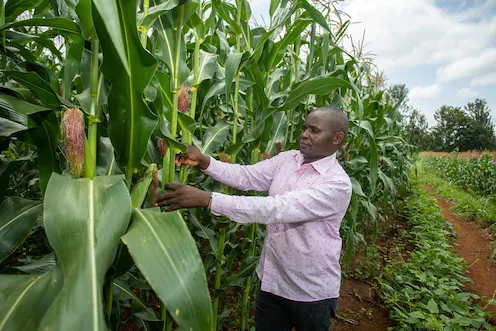Read in
One of humanity’s greatest achievements in the last century has been the massive increase in food production.
From 1900 to 2000, yields increased six times his, but the world population was less than four times his.So people today,on average, get about 50% more food than their great-grandparents.
Most of the increase in production is due to the farmer producing more food on his one hectare of land.This extraordinaryprogress is credited to the Green Revolution, which has greatly enhanced inputsinto modern agriculture.
Nobel Peace Prize-winning agronomist Norman Borlaug pioneered the strengthening of modern farmingmethods and isestimated to have saved more than one billion lives from hunger. The Green Revolution hasnot only fed people, it has alsomade society more prosperous. And as agriculture becomes moreefficient, people will be freed from tedious labor andengaged in a much wider range of productive activities.
The Green Revolution was an extraordinary achievement. But to extend benefits to the world’s poorestpeople and reduceworld hunger, the world needs a second green revolution.
It is especially needed today as the planet is under-fed. Since 2016, world leaders have made majordevelopmentcommitments to all countries by 2030, known as the Sustainable Development Goals.
One of our key goals focuses on ways to boost agriculture. From ending hunger to ensuring better nutritionand moresustainable agriculture.
Unfortunately, we cannot keep our promise. This is not just because Covid has stalled progress. Trackerpredicts that evenbased on pre-pandemic progress, the politician’s food promise won’t be met by his2030, and more than 80 years later, inhis early 21st century. is showing.
In fact, the whole world will neglect all of its important duties. In 2023, we’ve reached the midpoint of ourbig promise,but we’re still far from halfway there.
For this reason, my think tank, the Copenhagen Consensus, has worked with some of the world’s top heeconomists toidentify the most effective strategies in the time left.
If we cannot do everything, we must focus on the smartest solutions in all areas, including agriculture andhunger.
Our researchers examined many agricultural policies, such as fertilizer subsidies and increased irrigation.All of this bringsmoderate benefits to society, but the effect per franc invested is not surprising. Buthumanity has a clear opportunity.
A sharp increase in investment in agricultural research and development (R&D).
Poorer countries continue to suffer significant deficits in agricultural research and development. Largecompaniesunsurprisingly spend the most in rich countries, where large farmers have plenty of money.
For this reason, in 2015, 80% of global agricultural R&D funding went to wealthy and upper-middle-incomecountries,while lower-middle-income countries received only 20% of his. The world’s poorest countries,including Rwanda,received almost nothing.
This unequal investment has existed for more than half a century. This is one of the main reasons why theGreenRevolution has not helped the poorest countries as much as the rich. Grain yields in high income countries nearly tripled from 1961 to 2018, while his 50% increase in low-income countries was much smaller.
The untapped potential is huge. A study released this week by the Copenhagen Consensus found that theworld could reapbig benefits from spending a little more each year.
She estimates the additional cost of this decade of research and development to her at about $5.5 billionannually.
This investment will produce better seeds and higher-yielding crops, and will be better able to cope withweather changessuch as climate change. Growing larger, more resilient crops benefits farmers, andproducing more food helps lower pricesfor consumers. The total net benefits to farmers and consumers over the next 35 years will exceed $2 trillion. This is agreat investment as you get an amazing $33 in benefits for every dollar spent.
By 2050, this additional funding will increase agricultural production by 10%, reduce food prices by 16% andincrease percapita income by 4%. This investment would add $2.2 trillion to GDP in developing countriesby 2030 and $11.9 trillionby 2050, while increasing per capita income by 2% and 6%, respectively. Moreefficient agriculture also reduces globalclimate emissions by more than 1%. Agricultural research and development is a staggering investment. Because not onlyare we making our farm workers moreproductive, we’re getting more people to be more productive and innovative inother areas. As a result,fewer people go hungry and food costs less for everyone.
Not all promises to 2030 can be fulfilled. But we need to invest in agricultural research and developmentfor the poorestpeople on the planet. Because it’s one of the best investments mankind can make.
The author is chairman of his Consensus in Copenhagen and a visiting fellow at the Hoover Institutional StanfordUniversity.



